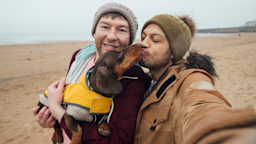Key takeaways:
Regular exercise benefits your pooch by stimulating their minds and promoting physical fitness.
Your dog’s daily exercise needs depend on their breed, age, and size and physical or mental health conditions they may have.
Watch your puppies and older dogs closely when they exercise. Too much activity can place too much stress on their bodies.
Exercise is good for you — and it’s good for your furry friends too. For dogs, daily walks are best because they provide mental stimulation as well as physical exercise. Walks also help you and your pup bond.
In addition to daily walks, there are plenty of other ways for your dog to exercise and lots of toys to make playtime more fun. But first, let’s look at how much exercise your dog needs.
How much exercise does a dog need?
How much exercise your dog needs depends on several factors. In general, it will range from 15 minutes a day to over an hour a day. You should take your pet for a walk at least once a day at around the same time.
Search and compare options
Factors that help determine how much exercise your dog needs include:
Age
Breed
Size
Energy level
One of the most important factors is your dog’s age. Here’s how much exercise your dog needs based on their age.
Puppies
Puppies tend to have more energy than adult dogs and require exercise in short bursts. Because puppies are always growing, it’s best to take them on several short walks throughout the day. Going on long walks once a day can harm their developing bodies.
Adult dogs
Adult dogs need regular exercise to stay fit, for enrichment, and to avoid obesity. As a rule, active breeds like border collies need to move more throughout the day than low-energy breeds like basset hounds.
Older dogs
Our older pups are more likely to have health issues like arthritis, vision loss, and dementia. But regular exercise is still important. Take shorter walks, and let your pet’s pace guide you. Follow familiar routes, and give them time to rest as needed.
Too hot to trot: When the temperature outside hits 85°F, it’s best to keep your dog inside. Learn more about when it’s too hot and too cold to walk dogs outside.
Can dogs catch a cold? Dogs can develop cold symptoms like a runny or stuffy nose, coughing, and sneezing. Here’s how to help if this happens to your pup.
Dog aggression: It may look scary, but dog aggression is often tied to fear or pain. Learn what could be causing your dog’s aggression and how you can help.
If possible, keep your older dog off concrete and asphalt. The hard surfaces can damage their joints. Look for grassy areas or woodland trails instead.
Quiz: What dog should you get?
How to calculate how much exercise your dog needs
In general, smaller and older dogs need less exercise than larger and younger dogs and highly active breeds.
You can use the World Animal Foundation’s tool to calculate your pup’s exercise requirements. The table below shows a sample of how much exercise dogs need based on their breed, age, and size.
Read more like this
Explore these related articles, suggested for readers like you.
Breed | Age | Size | Daily exercise needs |
Yorkshire terrier | 12 years old | Small | 15 minutes |
Beagle | 5 years old | Small | 30 minutes |
Dachshund | 1 year old | Small | 20 minutes |
French bulldog | 3 years old | Medium | 24 minutes |
Airedale terrier | 8 years old | Medium | 36 minutes |
German shepherd | 10 years old | Large | 45 minutes |
Golden retriever | 2 years old | Large | 68 minutes |
Labrador retriever | 7 years old | Large | 36 minutes |
Rottweiler | 4 years old | Large | 68 minutes |
Standard poodle | 9 years old | Large | 45 minutes |
How important is exercise for dogs?
Exercise is very important for dogs. Think about all the ways exercise is good for you. It helps you maintain your joint health, relieve stress, and strengthen muscles. The same is true of your pet.
Exercise contributes to your dog’s physical and mental health by:
Lowering the risk of obesity
Keeping joints mobile
Boosting muscle strength
Regulating the digestive tract
Promoting urinary tract health
Stimulating good mental health
Creating a bond between you and your animal
In addition to helping your dog, daily exercise can improve your health too.
How can you tell if your dog needs more exercise?
If your dog isn’t getting enough exercise, they may show some signs or changes in behavior. These signs include:
Weight gain
Destructive behavior, such as chewing on inappropriate items
Becoming depressed or withdrawn
Restlessness
Stiffness while moving
Regular exercise can help keep your dog from experiencing these behavioral changes.
Recommended exercises for dogs
Exercise for your dog doesn’t need to be limited to walks. Many forms of exercise and physical activity can benefit your dog’s well-being, including:
Taking your adult dog on hiking trails with you
Having your pup run alongside you when you cycle, Rollerblade, or skateboard (if your vet approves)
Swimming, especially for dogs with joint pain
Playing fetch
Pulling a sled or wagon for larger breeds
Engaging in obedience training
Running up stairs
Playing hide-and-seek
Playing tug-of-war
Going through an indoor or outdoor obstacle course to practice agility
How to tell when your dog has gotten too much exercise
Just like people, dogs can overdo it. These signs may mean your pup is all tuckered out:
Dragging behind
Acting exhausted
Collapsing
Avoiding a normally fun activity
Showing signs of joint pain like difficulty getting up and lying down
Being dehydrated (increased panting, dry gums)
Showing signs of heatstroke (excessive panting, vomiting, weakness, collapse)
Having raw paw pads
Having stiffness after walking
Is it OK to not walk your dog every day?
We all need a break from time to time, including your pet — a day of rest when you hang out with your fur baby at home. Chill days are especially important if you have a reactive dog — a canine who gets overly anxious on walks.
It’s also important to take breaks if the weather is too hot or cold for your pup. High heat puts them at risk for heat stroke and pad burns, and extreme cold raises their risk for hypothermia.
On days when you don’t go for a walk, you can turn to other forms of exercise, like playing fetch. Keep in mind that mental enrichment, like food puzzles and other games, can help keep your dog active and healthy.
Frequently asked questions
The number of walks a day that a dog needs depends on their age, breed, and size. Younger and larger dogs typically need more exercise than smaller and older dogs. At least one walk a day is usually ideal unless your dog shows signs of needing more or less exercise.
Dogs don’t typically need days off from walking. But your dog may need to take days off if they overexercise, they become anxious on walks, or the weather isn’t ideal. You can exercise your dog with other activities on those days, such as playing fetch, tug-of-war, or hide-and-seek.
Toys can make playtime more enjoyable for you and your pet. Consider stocking up on a few of the following:
Fetch toys like small rubber balls and discs
Tug toys like knotted ropes and rubber rings
Agility equipment such as tunnels, seesaws, and hurdles
Hanging bungee cords
Large rubber or tennis balls
Flirt poles
The number of walks a day that a dog needs depends on their age, breed, and size. Younger and larger dogs typically need more exercise than smaller and older dogs. At least one walk a day is usually ideal unless your dog shows signs of needing more or less exercise.
Dogs don’t typically need days off from walking. But your dog may need to take days off if they overexercise, they become anxious on walks, or the weather isn’t ideal. You can exercise your dog with other activities on those days, such as playing fetch, tug-of-war, or hide-and-seek.
Toys can make playtime more enjoyable for you and your pet. Consider stocking up on a few of the following:
Fetch toys like small rubber balls and discs
Tug toys like knotted ropes and rubber rings
Agility equipment such as tunnels, seesaws, and hurdles
Hanging bungee cords
Large rubber or tennis balls
Flirt poles
The bottom line
Exercise is a wonderful way to keep your pet healthy and happy. The amount of exercise your dog needs will depend on their age, breed, and size. Smaller and older dogs generally need less exercise compared with younger or larger dogs. Daily walks should mentally stimulate your pup while promoting physical fitness.
In addition to walks, playtime that includes games like fetch, tug-of-war, and hide-and-seek will also benefit your dog. Just remember, it’s OK to take a break occasionally. Dogs need downtime just like their owners.

Why trust our experts?



References
Bergman, L. (2020). Dog training: How to use rewards. Veterinary Partner.
British Columbia Society for the Prevention of Cruelty to Animals. (2023). Is your dog getting too much exercise?
Cooper, L. (n.d.). Thesis: Reactive dogs and exercise. The International School for Canine Psychology and Behaviour.
Huntington Beach Pet Hospital. (2018). Signs your dog isn’t getting enough exercise.
Larson, J. A. (2023). Nutrition and exercise for growing puppies. Veterinary Partner.
People’s Dispensary for Sick Animals. (n.d.). Exercising your dog.
People’s Dispensary for Sick Animals. (n.d.). Exercising your senior dog.
Spooner-Raymond, M. (2021). Walking your dog. Veterinary Partner.
Texas A&M University Veterinary Medicine & Biomedical Sciences. (2012). Benefits of exercising with your dog.
World Animal Foundation. (2024). Dog exercise calculator: How much exercise does my dog need


















